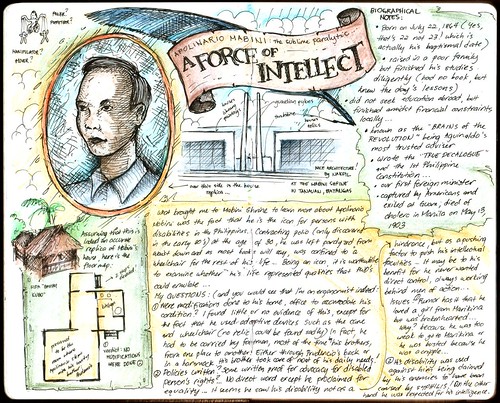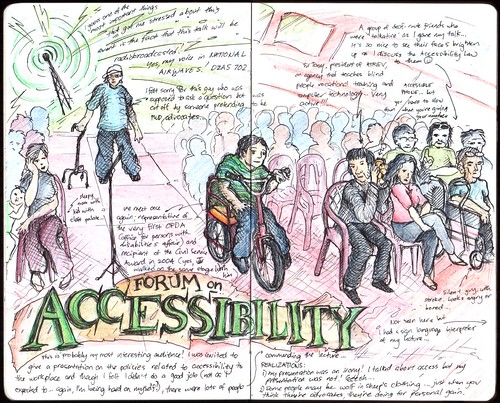
This year's theme for the National Disability Prevention and Rehabilitation Week (July 17 – 23, 2007) is "Kapag May Access, May Success!" It has that humorous ring in it, reminds one of the famous Department of Health slogans during the Flavier era. Honestly, I laughed out loud when it was announced that this will be this year's theme. And it brought similar amusing smiles from students and colleagues.
A week before this, Dean Jake requested me to represent the college in the Public Forum on Accessibility organized by the National Council for the Welfare of Disabled Persons (NCWDP) and Emilio Aguinaldo College, due to my background in environmental modification and ergonomics. Beside this, I will be very busy coordinating with the local government of San Mateo, Rizal and other stakeholders for a CBR Free Clinic and of course negotiations that will eventually lead to the assurance of infrastructures of the CBR Program in its new home. The transfer of CBR to San Mateo has really been giving me too much stress, and a series of setbacks would surely leave this job to be an excruciatingly worrisome one. One busy morning, I was contacted by NCWDP humbly requesting me to be the resource speaker for the Public Forum. It's quite funny that the forum that I'll end up as the speaker in the forum I was just supposed to attend to. I was aware of the amount of work I was required to finish, but this is a request that will be very difficult to turn down – actually, I had no choice but to accept it (as a government employee and a UP Professor, it is my civic responsibility). Besides, this wouldn't be too much work since I already have some materials for a presentation on "Public Policies Regarding Accessibility in the Workplace". Or so I thought…
Let me recount one of my little discoveries while I was preparing for the presentation, studying the pertinent laws and policies pertaining to the rights of persons with disabilities here in the Philippines. I have often wondered why the National Disability Prevention and Rehabilitation Week is specifically scheduled on the exact days of July 17 to July 23, and if you noticed this year, it started on a Tuesday and ended on Wednesday next week. Wouldn't it be more convenient if it was scheduled on the exact days of the week, from Monday to Sunday? Apparently it was originally declared every third week of July according to Proclamation No. 187 (enacted on June 22, 1979). However, this was changed to July 17 to 23 according to Proclamation No. 361 (signed on August 19, 2000), where the week should culminate on the birthdate of the sublime paralytic: Apolinario Mabini, who is identified as an outstanding icon for persons with disabilities because of his exemplary and dedicated heroic acts during the Philippine Revolution. Come to think of it, besides being identified as an exceptional hero, Mabini may very well be one of the first ever recorded Filipino person with disability who have held an office and served the local government. Numerous questions popped in my mind, and being an academician who teaches environmental modification to accommodate persons with disabilities it may not be surprising that I would wonder whether Mabini ever modified his home and working conditions and two) being an exceptional lawyer himself and author of prominent legal documents, did he ever write something, even some form of correspondence, that gave special privileges to persons with disability such as him. I even wrote Ambeth Ocampo, presently director of both the National Historical Institute and the National Commission for the Culture and Arts on this inquiry:
- Were there any accessibility features installed in the residences and place of work of Mabini to accommodate his condition? There are a lot of information regarding Mabini, being confined to a wheelchair, but I am curious whether he himself or his friends/family members did any changes/physical modification in the household and workplace to accommodate his condition. Was he fully independent at all times? How did he take his bath? Were his table and other furniture lowered? How about his transportation? (I believe there are illustrations of Mabini being carried in a hammock to enter his office).
- Being Aguinaldo's political advisor and considered as the "Brains of the Revolution" (being the proponent of the 1st Constitution of the Philippines and the Decalogue), did he write any correspondence, literature giving special attention to his disability? Did he correspond or befriended fellow "paralytics"? Were there any special privileges/arrangements given to him because of the fact that he was a paralytic?
I also visited the Mabini Shrine in Tanauan, Batangas to seek answers to these questions. Looking at the replica of his house and even accounts from descendants of Mabini himself, I found little evidence of modification. Besides the rattan wheelchair he used at home and in his office, no other accommodation was used. Now I am sure you will wonder how he managed at home and work, doing his daily activities and work tasks… he had always by his side his trusty brother who pledged to serve him at all times. If he had to be carried on his back, Prudencio, his brother will carry, cook, bathe him if necessary. He had to be carried on a hammock to travel from one place to another (from Batangas to Cavite).


Surely enough, just recently, I received a reply from Ambeth Ocampo:
"Prof. Cruz,
Greetings from the National Historical Institute!
Thank you for your letter regarding Apolinario Mabini. Regarding your questions about the hero, historical sources indicate that Mabini had to be carried around since his legs were paralyzed. Often he had furniture adjusted and lowered so he would be comfortable. Among the furniture in his house in Nagtahan are a chair and a bench to place his legs. From his condition he had to be assisted while he was taking a bath and during his exile in Guam, he was permitted to bring along his brother to take care of him. About his transportation, Mabini was carried around on a hammock. This was mentioned when Gen. Emilio Aguinaldo summoned him from Los Baños, Laguna to Kawit, Cavite. Around a hundred men took turns carrying him to his destination.
Regarding his disability, Mabini graciously accepted his condition. He even signed himself as "Paralitico" or "Lumpo." He did write something about his disability when he defended himself from his detractors who said that his disease (said to be venereal disease) might affect his reasoning. Mabini said that even he was physically handicapped he could still deliver wise counsel to the President of the Republic and serve as the country's first Chief Justice of the Supreme Court. Mabini wrote many letters to journalists as well as foreigners. As for the privileges extended to him, he was always assigned persons at his disposal to move him around. Even the Americans who captured him in 1899 gave him the same consideration and allowed him to move around while in exile in Guam.
It is hoped that this little information would be of help.
Sincerely,
Ambeth R. Ocampo"

I used this information as an introduction to my presentation. But for the main part of my lecture, rather than plainly presenting the list of pertinent laws related to accessibility to the workplace in the Philippines, I discussed the policies around a situation: a person with disability trying to get to work. All the issues one will encounter will be presented accordingly with a relevant policy. And it will be up for the audience to decide whether these policies are enforced or not. One thing we should realize though: We have very good laws. They are complete in a sense and encompasses all the relevant aspects of life of a person with disability, to the point that it can also rival those of other nations. We just don't have enough resolve and resources to enact these.
I had to deliver the presentation in Filipino, since it was also broadcasted through DZAS. The audience was probably the most unusual and interesting one. Imagine a group with all the various types of impairments and disabilities in one huge hall. I had an interpreter beside me delivering my lecture in sign language. I knew they were a "talkative" bunch because they were busy signing among themselves. I realized that my lecture was an irony in itself. I talked about access but my presentation was not accessible to everyone! (I had pictures in my slide presentation which I failed to describe… I kept referring to pictures in my slide, and the audience who were blind or visually impaired would seek assistance from their seatmates to describe to them what were in those pictures).

I ended my presentation with another historical tidbit related to Apolinario Mabini. One of the things I discovered when I visited the Mabini Shrine was that Mabini's birthday was not July 23! Apparently, it was recently discovered in documents that July 23 was actually his baptismal date. His real birthday was July 22, 1864. So I thought, should the Proclamation of the National Disability Prevention and Rehabilitation Week be once more amended to accommodate this recent discovery. On another thought, if this will be amended, should the rest of our policies be amended to accommodate our seemingly slow ability to enforce and enact these? Or should we rather amend our attitudes towards issues surrounding persons with disabilities?

I was just happy to have survived that hectic week, with the culmination of our CBR Free Clinic in San Mateo, Rizal. But the work is far from finished. And when I thought that there won't be any snags on the side of the municipal government with the transfer of CBR to San Mateo, little did I realize that the problem would come from the university itself… Stressful. To end it on a happy note, here are my mandatory source journal entry presentations:






No comments:
Post a Comment